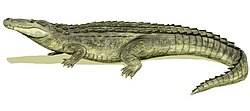| Maomingosuchus Temporal range: Late Eocene: Priabonian, | |
|---|---|
 | |
| Two fossils, Zhejiang Natural History Museum | |
| Scientific classification | |
| Kingdom: | Animalia |
| Phylum: | Chordata |
| Class: | Reptilia |
| Clade: | Archosauria |
| Order: | Crocodilia |
| Clade: | Longirostres |
| Superfamily: | Gavialoidea |
| Genus: | † Maomingosuchus Shan et al., 2017 |
| Species | |
| Synonyms | |
| |
Maomingosuchus is an extinct genus of gavialoid crocodylian from Late Eocene of Southeast Asia. It was discovered in Priabonian-aged deposits of China and possibly also Thailand. [2] The type species, originally Tomistoma petrolica, was named in 1958 [3] and was redescribed as Maomingosuchus in 2017. [4] A second species, Maomingosuchus acutirostris, was described in 2022 from middle-upper Eocence deposits (late Bartonian–Priabonian age, 39–35 Ma) of the Na Duong Basin in northern Vietnam. [5] It is proposed to be a basal member of Gavialoidea, [1] or alternatively within the family Tomistominae. [5] It was a relatively small gavialoid with an estimated total length of 3–3.5 metres (9.8–11.5 ft). [6] [4]



